The definition of a magic system introduced in installment one could be sharpened from "any set of rules designed to simulate supernatural powers and abilities" to "any set of rules and symbols designed to simulate the alteration of reality through the will." This definition echoes Crowley's first axiom from Magick in Theory and Practice ("magic is the science and art of causing change to occur in conformity with will"), though it can apply to games without requiring designers to buy into any particular philosophical scheme. Rather, an appreciation of magic requires only a little reflection on the profound mystery of the will: by deciding to do something, we can make it happen. For example, we focus our will to pick up a glass of water at lunch, and we do pick it up. Magic is an extension of similar taken-for-granted acts of will into a more profound longing: to control not just our immediate surroundings through the direct use of our body, but to shape nature, technology, other human beings, and the spirit world through the force of the will.
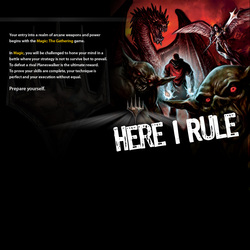 Perhaps most specifically, the fascination with magic stems from a desire to guide and shape the forces that govern the course of our individual human lives. The exercise of will to create change in life is murky and difficult, thwarted as it often is by forces both internal and external beyond our control. But in games, there is the potential of mastery, of understanding rules and then manipulating them through strategy in order to achieve a desired outcome. "Here I rule" is the marketing slogan of Magic: The Gathering, a declaration often accompanied by depictions of a skinny adolescent smirking confidently while surrounded by the fearsome monsters. As gamers, many of us identify with that sentiment.
Perhaps most specifically, the fascination with magic stems from a desire to guide and shape the forces that govern the course of our individual human lives. The exercise of will to create change in life is murky and difficult, thwarted as it often is by forces both internal and external beyond our control. But in games, there is the potential of mastery, of understanding rules and then manipulating them through strategy in order to achieve a desired outcome. "Here I rule" is the marketing slogan of Magic: The Gathering, a declaration often accompanied by depictions of a skinny adolescent smirking confidently while surrounded by the fearsome monsters. As gamers, many of us identify with that sentiment.
As magic systems in games evolve, various forms of alteration of reality become formalized into types or "schools" of magic to categorize the ways in which players can alter a simulated reality.
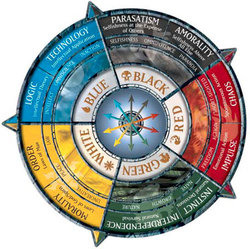
As early as 1976, Gary Gygax reflected on the varied possible effects of spells in his article "The D & D Magic System":
Spells do various things, and just what they do is an important consideration, for some order of effect in regard to the game would have to be determined. Magic purports to have these sorts of effects: 1) the alteration of existing substance (including its transposition or dissolution); 2) the creation of new substance; 3) the changing of normal functions of mind and/or body; 4) the addition of new functions to mind and/or body; 5) summon and/or command existing entities; and 6) create new entities. In considering these functions, comparatively weak and strong spells could be devised from any one of the six. Knowing the parameters within which the work was to be done then enabled the creation of the system.
Schools of magic evolve through the history of first-generation CRPG's such as The Bard's Tale and Wizardry until they solidify into a fairly uniform set of spell effects, with variations in individual spell possibilities from game to game. For example, the classic Bard's Tale (1985) divides magic into four schools: conjuring (damage and production of magical items), sorcery (illusion), magic (lingering spell effects), and wizardry (summoning creatures). As a relatively recent culmination of basic RPG magic schools (and of the single-player Western RPG generally), The Elder Scrolls IV: Oblivion (2006) offers a strong contemporary baseline for the possibilties of spell effects. Like Oblivion as a whole, the magic system is smoothly implemented and richly complex, if firmly grounded in the history of RPG's and not particularly original.
Oblivion features six schools: Destruction (damage), Alteration (buffing), Illusion (sensory deceptions like invisibility and silence), Conjuration (summoning creatures, especially daedra), Restoration (healing), and Mysticism (harnessing unusual telekinetic effects and the ability to detect life by lighting up all living creatures on the map). The fascination of the school of mysticism in Oblivion suggests that magic systems can be most interesting from a gameplay perspective when they incorporate as many of the game's mechanics and systems as possible, rather than restricting themselves to combat or character statistics. This extension of magic beyond combat and healing (or its enmeshment with more sophisticated combat systems) requires clever programming to implement.
Based on a historical consideration of magic systems, common schools of magic, present in almost any RPG, include:
• Damage;
• Healing;
• Buffing (raising stats of character or item);
• Summoning;
Less common schools include:
• Telekinesis;
• Architecture (opening, closing, moving, building);
• Sight (or insight);
• Teleportation (especially interdimensional);
• Mapping and navigation;
• Illusion and dispelling illusion;
One problem with magic systems, especially those focused on damage and healing, is a tendency to rely on a simplistic cosmology based on the four classical elements of the ancient Greeks (earth, air, water, and fire). MMO's abound in fire and ice mages, as well as an endless parade of wizards, druids, and shamans who manipulate the powers of the four elements. Even obscure cult classics lauded by their devotees for innovative customizable spell systems (such as Magic and Mayhem: The Art of Magic [2001] and The Dawn of Magic [2005]) end up falling back on combinations of the four elements, sometimes with light and darkness or chaos and order thrown in for good measure. While this cosmology can result in many flashy damage spells with stunning particle effects and explosions, it is a reduction of human experience that soon seems routine rather than enchanted. The experience of fire and water are certainly primal and compelling, as anyone who has witnessed a forest blaze or an ocean tempest can attest. Yet, both in day to day life and the furthest flights of our imaginations, we do more than admire campfires and swim; consequently, in simulated magic we should do more than throw fireballs and iceblasts.
In contrast to this simplification of reality down to four physical elements, schools of magic eventually evolve into or intersect with a larger cosmological ambition of mapping out reality. Pragmatic considerations of how to simulate alterations of reality leads to philosophical reflection on what aspects of reality can be altered, resulting in a kind of metaphysical taxonomy.
To display these abstract concepts in ways that are easily graspable for use in gameplay, designers often assign symbolic colors to schools of magic.
Examples include:
• The color pie in Magic: The Gathering (1993);
• The eight winds of magic in Warhammer (both tabletop[1987] and online[2008]);
• In Eternal Darkness (2002), the colors associated with the runic magick of the three Ancients (as well as a hidden purple rune, and an implied yellow school of magick discussed by Denis Dyack in The Escapist)
• The colors of magic corresponding to the spheres of magic in Mage: The Ascension (1993) 1. Correspondence: Purple 2. Life: Red 3. Prime: White 4. Entropy: Indigo 5. Matter: Brown 6. Spirit: Gold 7. Forces: Orange 8. Mind: Blue 9. Time: Green
• The nine colored pillars of Nosgoth in Blood Omen: The Legacy of Kain (1996) and their associated spheres of "Death, Conflict, States, Energy, Time, Dimension, Nature, Mind, and Balance"
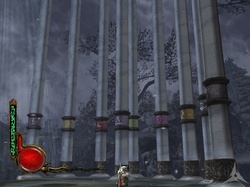 In all of these examples, the cosmology simulated or implied by the schools of magic substantially richer and more complex than the four elements or the opposition of law and chaos. Symbolic color also resonates with a deep-seated human association between mood and color (which results in entire design classes on color theory), as well as occultist tendency to assign esoteric meaning to color (as in the King and Queen scales of the Golden Dawn and their display in tarot as well as the Rosicrucian-inspired Vault of the Adepti).
In all of these examples, the cosmology simulated or implied by the schools of magic substantially richer and more complex than the four elements or the opposition of law and chaos. Symbolic color also resonates with a deep-seated human association between mood and color (which results in entire design classes on color theory), as well as occultist tendency to assign esoteric meaning to color (as in the King and Queen scales of the Golden Dawn and their display in tarot as well as the Rosicrucian-inspired Vault of the Adepti).
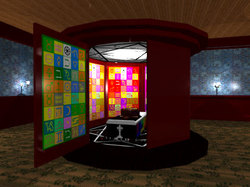 The metaphysical taxonomy of reality in magic systems occurs to varying degrees of depth, ranging from flavor text in small or large amounts [the backs of Magic: The Gathering cards exemplify short flavor text, while the codexes/codices in Dragon Age contain more elaborate philosophical ruminations] to deep integration with gameplay. As such, these metaphysical mappings of reality tend resemble both tarot and kabbalistic mappings of the universe in the tree of life, which in the Golden Dawn system has many associated attributions of colors, tarot cards, and other elements.
The metaphysical taxonomy of reality in magic systems occurs to varying degrees of depth, ranging from flavor text in small or large amounts [the backs of Magic: The Gathering cards exemplify short flavor text, while the codexes/codices in Dragon Age contain more elaborate philosophical ruminations] to deep integration with gameplay. As such, these metaphysical mappings of reality tend resemble both tarot and kabbalistic mappings of the universe in the tree of life, which in the Golden Dawn system has many associated attributions of colors, tarot cards, and other elements.
At this point, magic begins to intersect with planar lore: specifically, the idea of a multiverse with many different dimensions or planes, a notion derived from many realms of mysticism, including the Theosophic lore of Madam Blavatsky (in which the particular term "plane" gains popularity). (As for multiverse, the word shows up in the philosophical writings of Henry James and is later popularized in the Eternal Champion saga of Michael Moorcock). The first meeting of the planes and magic appear in Dungeons and Dragons supplements, such as The Manual of the Planes (1987) and the Planescape campaign. The principle of planar magic is that "belief and imagination rule the multiverse," so that one's philosophical outlook can directly shape physical reality if those beliefs are held with sufficient strength. The planar cosmology results in a radial diagram called the Great Wheel, whose dimensions do correlate with the various alignment possibilities of the D & D moral universe. While the permutations of "lawful," "chaotic," "good," "evil," and "neutral" are in their own way as limited as the four elements, the factions of Planescape are philosophically nuanced and sophisticated, representing the dense concepts of solipsism (the Sign of One) and anarchism (the Xaosects).
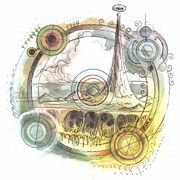 Similarly, in Magic: The Gathering, dueling magicians called Planeswalkers gain their different colors of mana from multiple planes of existence in the multiverse. Magic's colors bear a superficial relation to three out of the four elements (red = fire, green = earth, blue = water). Yet, the five colors of mana represent a more abstract and nuanced set of human experiences. According to the official released color pie and the official site of Magic, the following color correspondences apply:
Similarly, in Magic: The Gathering, dueling magicians called Planeswalkers gain their different colors of mana from multiple planes of existence in the multiverse. Magic's colors bear a superficial relation to three out of the four elements (red = fire, green = earth, blue = water). Yet, the five colors of mana represent a more abstract and nuanced set of human experiences. According to the official released color pie and the official site of Magic, the following color correspondences apply:
• Red = chaos and impulse
• Green = life and growth
• Blue = deception, calculation, and illusion
• Black = ambition and power
• White = order and justice
Magic: The Gathering is relatively unique in that its multi-colored schools of magic manifest primarily through gameplay and are only reinforced through flavor text and images. For example, as the school of ambition and control, black magic entails seeking mastery of the game at any cost, resulting in a mechanic of sacrifice in which black strategically gives up any resource (creatures, mana, life points, graveyard cards) in order to gain an advantage. As the school of freedom and impulse, red magic involves a mechanic of quickly doing damage that either gains a decisive advantage early or loses within a few rounds.
Passing beyond the colored schools of magic is the dark, often forbidden school of blood
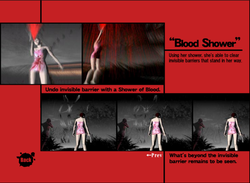 magic, which appears in many games as one example of how to push outside the constraints of elemental damage and law versus chaos cosmology. Blood Magic often shows up in horror-themed games, sometimes vampiric and at other times simply Gothic. All of the magic in Vampire the Masquerade: Redemption (2000) involves ghoulish varieties of blood magic, as does the similarly-themed Gothic vampire game Blood Omen: The Legacy of Kain (1996). Blood Magic also shows up as a hidden school in Dragon Age. In each case, blood magic involves especially gory and disturbing varieties of RPG gameplay, ranging from gory damage and restoration spells to mental manipulation powered by human sacrifice.
magic, which appears in many games as one example of how to push outside the constraints of elemental damage and law versus chaos cosmology. Blood Magic often shows up in horror-themed games, sometimes vampiric and at other times simply Gothic. All of the magic in Vampire the Masquerade: Redemption (2000) involves ghoulish varieties of blood magic, as does the similarly-themed Gothic vampire game Blood Omen: The Legacy of Kain (1996). Blood Magic also shows up as a hidden school in Dragon Age. In each case, blood magic involves especially gory and disturbing varieties of RPG gameplay, ranging from gory damage and restoration spells to mental manipulation powered by human sacrifice.
However, the two most striking implementations of blood magic appear in the cult Killer7 and the horror-themed squad-based shooter, Jericho (2007). In Killer7, Kaede Smith, a svelte and ferocious beauty with a Gothic pallor, slits her own arms to release a spray of blood, which is then channeled by a phantom bondage queen in order to dissolve barriers. Kaede Smith's blood magic opens barriers, both literal and metaphorical, by using her trauma to see beyond the apparently solid limitations of the physical world as experienced by the other six assassin personalities. The metaphorical element of breaking through barriers is more strongly highlighted in a game that foregrounds its own preoccupation with transcendent insight through imagery of a third eye, including a health meter on the HUD which is itself a gradually opening and closing eye. (In Killer7, blood magic is part of a larger (and highly taboo) thematic preoccupation with disability and sadomasochism. Harman Smith, an assassin whose participation in a game of cosmic chess borders on godlike, is also a wheelchair-bound masochist who alternates dispensation of Zen-like wisdom with dominatrix sessions at the hands of young woman doubling as his maid.)
A similar character appears in Clive Barker's Jericho in the form of Billie Church, a Blood Mage. Jericho is an enjoyably horrific game whose squad-based AI is somewhat broken, but this one element of magic in its paranormal squad-based arsenal is powerfully successful. Billie is a lapsed Southern Baptist, abused by her father and institutionalized in an insane asylum, where demons carved biblical verses into her flesh. In gameplay, she uses her katana to carve glyphs in her arms, which then explode into tendrils and bulbs of blood, enwrapping and immobilizing enemies, who can then be sliced to ribbons or blown to bits. Like Kaede Smith, Billie makes a sacrifice of her most precious life fluid for insight, in a maneuver that Barker calls (in other contexts) "using the wound"--a deliberate exploitation of debilitation and trauma as paradoxical means of shamanic enlightenment.
 Barker's use of blood magic parallels his own attempts as a designer to expand and deepen the variety of spell effects, seen perhaps more effectively in the cult horror classic FPS Undying (2001). Undying features a scry spell that allows players to see beyond the veil into hidden sights, such as apparitions and messages scrawled in blood. As Barker memorably and humorously explains:
Barker's use of blood magic parallels his own attempts as a designer to expand and deepen the variety of spell effects, seen perhaps more effectively in the cult horror classic FPS Undying (2001). Undying features a scry spell that allows players to see beyond the veil into hidden sights, such as apparitions and messages scrawled in blood. As Barker memorably and humorously explains:
Undying is about being smarter, faster, cleverer, and a better magician than a gunslinger. It's about magic. The idea of scrying--seeing things you normally can't see--is very interesting. Much more interesting than a f_g big gun. We've seen that stuff before. I think that's had its day. I think as the new millennium has dawned, we are in a different kind of space. We think more spiritually, we think more about magic and transformation. We think more about the self rather than how many guns we can muster. I'm not saying that Undying is a metaphysical treatise, but its heart is not in the big gun territory.
The presence of innovative spells in games like Undying and Killer7 suggests that in order to expand the diversity of useful spell effects and schools of magic, we need to look outside of the RPG genre into other genres that sometimes simulate magic, like survival horror, first-person shooters, strategy games, and action-adventure games.
Game genre shapes game world, which dictates the affordances and limitations of spellcasting, i.e. what is possible in magic and what is useful. In next week's installment, I will examine some of these game genres, with particular attention to magic and horror, and what they have to teach us as designers of magic systems.


Fire Emblem relies heavily on Rock Paper Scissors for its weapon usage. Sword -> Axe -> Lance -> Sword is a staple. The Game Boy Advance games put Fire Ice Wind and Lightning into a single category, Anima, and then did Anima -> Light -> Darkness -> Anima for their spells. These games also have bows and staves (healing and status effects) as non elemental abilities. Other Fire Emblem games split Anima into Fire Wind Lightning, with Fire -> Wind -> Lightning -> Fire, but still kept them in the Anima category when fighting Light or Dark users.
Have you noticed how much physical attacks get split and separated? Many Video Game RPGs treat physical attacks as its own system, with a separate offense and defense mechanic from magic (example: Dragon Quest.) Some split it up between Slashing, Piercing and Bludgeoning (Dungeons and Dragons.) Some consider physical attacks just one of the many elements and treat it like the others. City of Heroes, for example, has Smashing, Lethal, Fire, Cold, Energy, Negative Energy, Psionic and Toxic damage (and the very rare Untyped damage.) Some games consider powerful physical attacks Earth(for Smashing) or Wind(for Cutting) damage types.
@Chad:
Thanks again for your informed comments.
That's cool that the Fire Emblem series adds some interesting wrinkles to the concept of elemental damage. I've been playing Vagrant Story (a wonderful and dark late PSX game from Squaresoft), and it also complicates the idea of elemental damage through individual weapon affinities for particular enemies. These affinities grow through use (weapons level up more frequently than characters) and can be modified through a staggeringly complex weapon forging system. Vagrant Story is a game that is very much thematically concerned with the magic of grimoires and sigils, but its magic system is fairly simple. The true magic system is disguised as a combat and weapon creation system.
This leads me to share your interest in the ways that physical damage is separated from magic and then divided up into several varieties of attack. The role of magic in combat and combat in magic tends to blur the lines between the two types of systems so much that I decided to teach a class on "Magic and Combat Systems" in the fall.
At the same time, I do long for a greater variety of non-combat spell effects, like scrying and teleportation. This would make magic feel more visionary and imaginative rather than just another form of combat with flashier special effects.
Let's see...
Non-combat spell effects are frequently environmental transformations: breaking or unlocking doors, freezing or melting water, creating wind, dispelling barriers (as you gorily describe above). Plus, of course, the old standby of "transform the world into a creepy distorted form" (or vice versa) -- prominent in the Soul Reaver series, which also had a nice little elemental-environmental magic system going.
I wish _Undying_ had gotten *farther* away from the "BFGun". The scry spell was a nice idea, but not very deep in the end; and (as I recall) most of the other spells were magic-ized Quake weapons.
Yes, environmental transformations are an important and often neglected school of magic, maybe because they require a close collaboration between designers, level designers, and programmers. The Soul Reaver games do an excellent job with these spell effects, especially the "shift dimension" spell that you mention (since it includes gameplay effects of activating light portals and enabling passage through doors otherwise impassable in physical form).
I think moving through alternate dimensions is an extremely important and too seldom used spell effect, which gets to the heart of shamanic tradition and what new agers call astral projection. Other than the Soul Reaver games, I wonder if there are other examples of magic used to travel in this way? (Realms of the Haunting featured interdimensional travel, but I'm not sure how closely tied to magic).
As for Undying, it was interesting for its smooth implementation of magic in an FPS: its two-fisted style of shooting with one hand and casting with another (or casting with one hand and intensifying the spell with a scrying stone in the other). First-person spell casting lends an immersiveness and immediacy to magic that is often lacking in RPG's, except for action-RPG's like Oblivion. In Undying, the spells had a certain amount of occult authenticity (spells for invoking and banishing) and Gothic flair (skullstorm, in which the player pulls flaming, screeching skulls out of graveyard areas and flings them at enemies). But you are right that a greater variety of non-combat spells and perhaps a deeper use of combat magic would have helped make good on Barker's stated desire. (The spells in his novel Imajica are deeply metaphysical and abstract, and I wish that designers would try to implement more effects along those lines).
You make good points in favor of innovation over the use of classical elements, but when you argue against them, all you mention is fireballs and ice blasts. What is wrong with extending the four classical elements into further references, such as emotion (ardor/fire, joy/earth, sorrow/water, fear/air), energy (thermal/fire, potential/earth, kinetic/water, electricity/air), personal manipulation (scare/fire, direct/earth, charm/water, bluff/air), or transmutation (of morale/fire, of body/earth, of mind/water, of emotion/air)?
The four classical elements have been symbolic to humans since ancient times; it is something easy to understand and accept. States of matter can even be matched to these (plasma/fire, solid/earth, liquid/water, gas/air), giving them a more modern feel if that is necessary - manipulation of each, or transmutation of one to another, could provide a measure of interest in a game or story. Utilizing correspondences provides additional outlets for use in magic (fire is impulsive, destructive, and purifying; earth is strong, stable, and abundant; water is intuitive, healing, and emotional; air is linked to the mind, intellect, and communication). Even primal concepts can be linked to the four elements (Energy/fire, Matter/earth, Time/water, Space/air), as can environmental interaction (spirit projection/fire, object manipulation/earth, weather control/water, telekinesis/air) and creatures (beasts/fire, insects/earth, fish/water, birds/air).
Combining aspects from the above statements, a fire mage is no longer just the walking rocket launcher; he is a manipulator of morale and energy, possibly capable of enhancing or destroying magic itself and, given his capacity for heat and flame, likely skilled at the forge. Earth shamans not only launch spheres of stone but communicate with the tiniest of spies, raise a phalanx in moments, and provide joy and bounty to those they protect. A water witch is not just an ice queen; she speaks with entities of the ocean, provides healing, and can provide much needed rain for crops or fog for an escape. An air sorceress could call down lightning, but she may provide flight, allow communications between distant parties, trick enemies with illusion or speech, or protect her party from incoming attack by blowing the attack away - literally.
I do not personally believe in simply writing off the elements when things can be done to expand them further and pull them away from simple fireballs, kinetic waves, ice clouds, and lightning bolts; however, the manipulation of energies - something which can be emulated with science (flamethrower, concussion grenade, liquid nitrogen, Tesla coil) - is a primary aspect of magic and should not be dismissed because it has been done before. The greatest reason that it has all been done before is that it has worked well; ergo, why would someone choose to dismiss all of that potential?
Douglas, I think the point Jeff is trying to make is magic systems are very little more than chucking a fireball. There is no tie between magic and the world. What you were just describing is the opposite, moving toward what Jeff is advocating, a magic system so entwined with the universe its in that one couldn't exist without the other.